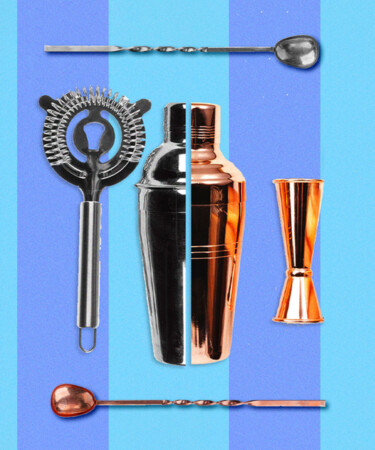Bar tools matter for any bartender who cares about making a balanced, delicious cocktail. Any hardcore drinks aficionado may tell you that using the wrong type of utensil can radically alter the integrity and intent of a drink — especially after they finish recoiling in horror from seeing a Martini shaken, not stirred. The integrity and materials of the tools also makes a difference, since bartenders may be using them constantly when they are in the weeds on a busy weekend.
These are just some of the factors to consider when discussing the use of copper or stainless steel tools in a bar program. To find out the rest, we talked to Charles Friedrichs, principal bartender at The Jones Assembly in Oklahoma City.
Form Follows Function
In the kitchen, copper’s ability to gain and lose heat more efficiently than stainless steel makes it the metal of choice when cooking dainty proteins or whipping up a savory sauce. According to Friedrichs, though, this scientific principle doesn’t really come into play when shaking a cocktail in a copper vessel. “I don’t see a practical difference between one or the other when you’re shaking a drink, just because the time that a cocktail spends in a shaker is negligible,” he says. “You’re going to be shaking a drink for about 15 to 20 seconds. That’s not enough time for heat transfer to happen.”
Even if copper’s scientific properties don’t impact the integrity of a Whiskey Sour, a Cosmopolitan, or another shaken drink, Friedrichs prefers using stainless steel bar tools over copper. This is because copper bar tools can compromise the integrity of a cocktail if they’re used heavily over time. “Most copper bar tools are just copper-plated. If you’re using copper for a sustained amount of time, that copper plating will start to chip away,” he explains. “This is important to bear in mind because bar tools get beat up. A copper bar spoon that’s repeatedly hitting ice can start having the copper flake off into the drink when it’s used for stirring.”
This doesn’t mean Friedrichs is completely against having copper at his bar. Copper mugs are still the vessel of choice when serving a Moscow Mule. “It’s standard operating procedure, tied to tradition,” he says. He says he’s also not totally opposed to using copper shakers, but that there’s a caveat “You may see a shaker with a copper exterior, but they may still have a stainless steel interior,” he says. “I’m not against using copper shakers, but the inside must be stainless steel.”
A Good-Looking Addition
While Friedrichs gravitates toward stainless steel bar tools for The Jones Assembly’s bar program, it’s important to note that he and his team crank out a hefty number of drinks six nights a week. Home bartenders will obviously use their tools more sporadically, which means they won’t be as subject to the amount of wear and tear bar tools may face in a professional’s hands. Because of this, Friedrichs says that using copper tools at home is perfectly fine, particularly since copper’s warm elegance gives it a decorative edge over its more industrial, utilitarian counterpart. “Copper has a great aesthetic,” he says. “If you like what copper looks like and it makes you happy, then go for it. Just make sure you’re keeping an eye on them and making sure they’re in good shape. Using them for your home bar follows the same principle as drinking in general. You should drink what you like, so you should use what you like.”
